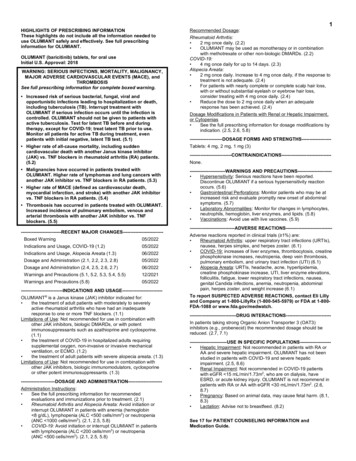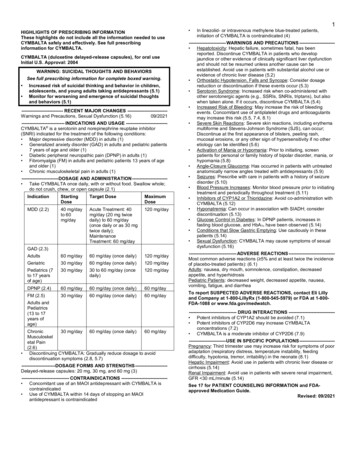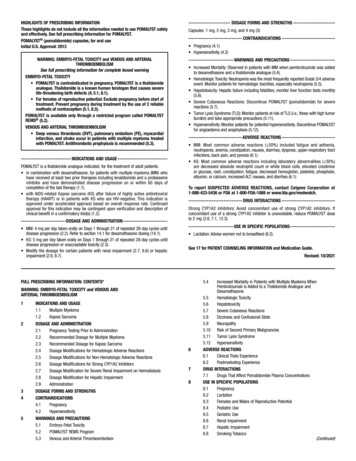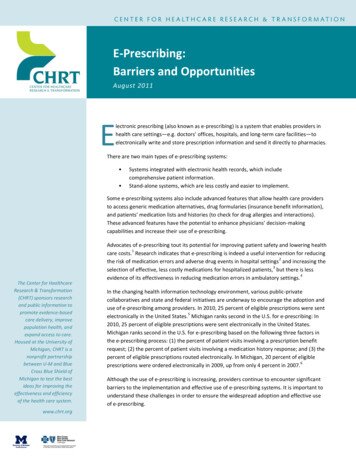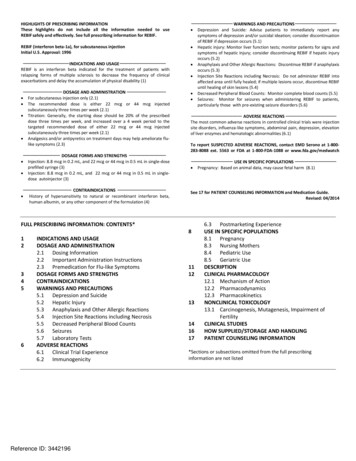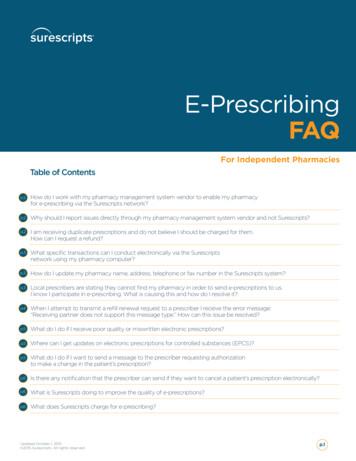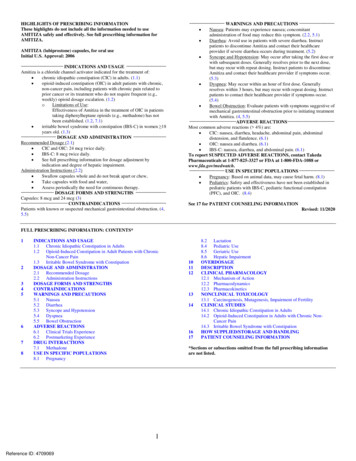
Transcription
HIGHLIGHTS OF PRESCRIBING INFORMATIONThese highlights do not include all the information needed to useAMITIZA safely and effectively. See full prescribing information forAMITIZA.AMITIZA (lubiprostone) capsules, for oral useInitial U.S. Approval: 2006INDICATIONS AND USAGEAmitiza is a chloride channel activator indicated for the treatment of: chronic idiopathic constipation (CIC) in adults. (1.1) opioid-induced constipation (OIC) in adult patients with chronic,non-cancer pain, including patients with chronic pain related toprior cancer or its treatment who do not require frequent (e.g.,weekly) opioid dosage escalation. (1.2)oLimitations of Use:Effectiveness of Amitiza in the treatment of OIC in patientstaking diphenylheptane opioids (e.g., methadone) has notbeen established. (1.2, 7.1) irritable bowel syndrome with constipation (IBS-C) in women 18years old. (1.3)DOSAGE AND ADMINISTRATIONRecommended Dosage (2.1) CIC and OIC: 24 mcg twice daily. IBS-C: 8 mcg twice daily. See full prescribing information for dosage adjustment byindication and degree of hepatic impairment.Administration Instructions (2.2) Swallow capsules whole and do not break apart or chew, Take capsules with food and water, Assess periodically the need for continuous therapy.DOSAGE FORMS AND STRENGTHSCapsules: 8 mcg and 24 mcg (3)CONTRAINDICATIONSPatients with known or suspected mechanical gastrointestinal obstruction. (4,5.5)WARNINGS AND PRECAUTIONS Nausea: Patients may experience nausea; concomitantadministration of food may reduce this symptom. (2.2, 5.1) Diarrhea: Avoid use in patients with severe diarrhea. Instructpatients to discontinue Amitiza and contact their healthcareprovider if severe diarrhea occurs during treatment. (5.2) Syncope and Hypotension: May occur after taking the first dose orwith subsequent doses. Generally resolves prior to the next dose,but may recur with repeat dosing. Instruct patients to discontinueAmitiza and contact their healthcare provider if symptoms occur.(5.3) Dyspnea: May occur within an hour of first dose. Generallyresolves within 3 hours, but may recur with repeat dosing. Instructpatients to contact their healthcare provider if symptoms occur.(5.4) Bowel Obstruction: Evaluate patients with symptoms suggestive ofmechanical gastrointestinal obstruction prior to initiating treatmentwith Amitiza. (4, 5.5)ADVERSE REACTIONSMost common adverse reactions ( 4%) are: CIC: nausea, diarrhea, headache, abdominal pain, abdominaldistension, and flatulence. (6.1) OIC: nausea and diarrhea. (6.1) IBS-C: nausea, diarrhea, and abdominal pain. (6.1)To report SUSPECTED ADVERSE REACTIONS, contact TakedaPharmaceuticals at 1-877-825-3327 or FDA at 1-800-FDA-1088 orwww.fda.gov/medwatch.USE IN SPECIFIC POPULATIONS Pregnancy: Based on animal data, may cause fetal harm. (8.1) Pediatrics: Safety and effectiveness have not been established inpediatric patients with IBS-C, pediatric functional constipation(PFC), and OIC. (8.4)See 17 for PATIENT COUNSELING INFORMATIONRevised: 11/2020FULL PRESCRIBING INFORMATION: CONTENTS*12345678INDICATIONS AND USAGE1.1 Chronic Idiopathic Constipation in Adults1.2 Opioid-Induced Constipation in Adult Patients with ChronicNon-Cancer Pain1.3 Irritable Bowel Syndrome with ConstipationDOSAGE AND ADMINISTRATION2.1 Recommended Dosage2.2 Administration InstructionsDOSAGE FORMS AND STRENGTHSCONTRAINDICATIONSWARNINGS AND PRECAUTIONS5.1 Nausea5.2 Diarrhea5.3 Syncope and Hypotension5.4 Dyspnea5.5 Bowel ObstructionADVERSE REACTIONS6.1 Clinical Trials Experience6.2 Postmarketing ExperienceDRUG INTERACTIONS7.1 MethadoneUSE IN SPECIFIC POPULATIONS8.1 Pregnancy1Reference ID: 4709069101112131416178.2 Lactation8.4 Pediatric Use8.5 Geriatric Use8.6 Hepatic ImpairmentOVERDOSAGEDESCRIPTIONCLINICAL PHARMACOLOGY12.1 Mechanism of Action12.2 Pharmacodynamics12.3 PharmacokineticsNONCLINICAL TOXICOLOGY13.1 Carcinogenesis, Mutagenesis, Impairment of FertilityCLINICAL STUDIES14.1 Chronic Idiopathic Constipation in Adults14.2 Opioid-Induced Constipation in Adults with Chronic NonCancer Pain14.3 Irritable Bowel Syndrome with ConstipationHOW SUPPLIED/STORAGE AND HANDLINGPATIENT COUNSELING INFORMATION*Sections or subsections omitted from the full prescribing informationare not listed.
FULL PRESCRIBING INFORMATION1INDICATIONS AND USAGE1.1Chronic Idiopathic Constipation in AdultsAmitiza is indicated for the treatment of chronic idiopathic constipation (CIC) in adults.1.2Opioid-Induced Constipation in Adult Patients with Chronic NonCancer PainAmitiza is indicated for the treatment of opioid-induced constipation (OIC) in adult patients withchronic non-cancer pain, including patients with chronic pain related to prior cancer or itstreatment who do not require frequent (e.g., weekly) opioid dosage escalation.Limitations of Use:Effectiveness of Amitiza in the treatment of opioid-induced constipation in patients takingdiphenylheptane opioids (e.g., methadone) has not been established. [see Clinical Studies (14.2)]1.3Irritable Bowel Syndrome with ConstipationAmitiza is indicated for the treatment of irritable bowel syndrome with constipation (IBS-C) inwomen at least 18 years old.2DOSAGE AND ADMINISTRATION2.1Recommended DosageThe recommended oral dosage of Amitiza by indication and adjustments for patients withmoderate (Child Pugh Class B) and severe (Child Pugh Class C) hepatic impairment are shownin Table 1.Table 1:Recommended Dosage RegimenCIC and OICIBS-CRecommended AdultDosage Regimen24 mcg twice daily8 mcg twice dailyDosage Adjustment forHepatic Impairment[see Use in SpecificPopulations (8.6)]Moderate Impairment(Child-Pugh Class B):16 mcg twice daily*Moderate Impairment(Child-Pugh Class B):No adjustment necessarySevere Impairment(Child-Pugh Class C):8 mcg twice daily*Severe Impairment(Child-Pugh Class C):8 mcg once daily**If the dose is tolerated and an adequate response has not been obtained after an appropriate interval, doses can thenbe escalated to full dosing with appropriate monitoring of patient response.2Reference ID: 4709069
2.2Administration Instructions Take Amitiza orally with food and water. Swallow capsules whole and do not break apart or chew. Physicians and patients should periodically assess the need for continued therapy.3DOSAGE FORMS AND STRENGTHSAmitiza is available as an oval, gelatin capsule containing 8 mcg or 24 mcg of lubiprostone.4 8 mcg capsules are pink and are printed with “SPI” on one side 24 mcg capsules are orange and are printed with “SPI” on one sideCONTRAINDICATIONSAmitiza is contraindicated in patients with known or suspected mechanical gastrointestinalobstruction [see Warnings and Precautions (5.5)].5WARNINGS AND PRECAUTIONS5.1NauseaPatients taking Amitiza may experience nausea. Concomitant administration of food withAmitiza may reduce symptoms of nausea [see Adverse Reactions (6.1)].5.2DiarrheaAvoid use of Amitiza in patients with severe diarrhea. Patients should be aware of the possibleoccurrence of diarrhea during treatment. Instruct patients to discontinue Amitiza and contacttheir healthcare provider if severe diarrhea occurs [see Adverse Reactions (6.1)].5.3Syncope and HypotensionSyncope and hypotension have been reported with Amitiza in the postmarketing setting and afew of these adverse reactions resulted in hospitalization. Most cases occurred in patients taking24 mcg twice daily and some occurred within an hour after taking the first dose or subsequentdoses of Amitiza. Some patients had concomitant diarrhea or vomiting prior to developing theadverse reaction. Syncope and hypotension generally resolved following Amitiza discontinuationor prior to next dose, but recurrence has been reported with subsequent doses. Several casesreported concomitant use of medications known to lower blood pressure, which may increase therisk for the development of syncope or hypotension.Patients should be aware of the risk of syncope and hypotension during treatment and that otheradverse reactions may increase this risk, such as diarrhea or vomiting.3Reference ID: 4709069
5.4DyspneaIn clinical trials, dyspnea was reported by 3%, 1%, and 1% of the treated CIC, OIC, and IBS-Cpopulations receiving Amitiza, respectively, compared to 0%, 1%, and 1% of placebo-treatedpatients. There have been postmarketing reports of dyspnea when using Amitiza 24 mcg twicedaily. Some patients have discontinued treatment because of dyspnea. These events have usuallybeen described as a sensation of chest tightness and difficulty taking in a breath, and generallyhave an acute onset within 30 to 60 minutes after taking the first dose. They generally resolvewithin a few hours after taking the dose, but recurrence has been frequently reported withsubsequent doses. Instruct patients to contact their healthcare provider if dyspnea occurs.5.5Bowel ObstructionIn patients with symptoms suggestive of mechanical gastrointestinal obstruction, perform athorough evaluation to confirm the absence of an obstruction prior to initiating therapy withAmitiza [see Contraindications (4)].6ADVERSE REACTIONSThe following adverse reactions are described below and elsewhere in labeling:6.1 Nausea [see Warnings and Precautions (5.1)] Diarrhea [see Warnings and Precautions (5.2)] Syncope and Hypotension [see Warnings and Precautions (5.3)] Dyspnea [see Warnings and Precautions (5.4)]Clinical Trials ExperienceBecause clinical studies are conducted under widely varying conditions, adverse reaction ratesobserved in the clinical studies of a drug cannot be directly compared to rates in the clinicalstudies of another drug and may not reflect the rates observed in practice.During clinical development of Amitiza for CIC, OIC, and IBS-C, 1648 patients were treatedwith Amitiza for 6 months and 710 patients were treated for 1 year (not mutually exclusive).Chronic Idiopathic ConstipationAdverse reactions in adult dose-finding, efficacy, and long-term clinical studies: The datadescribed below reflect exposure to Amitiza 24 mcg twice daily in 1113 patients with CIC over3- or 4-week, 6-month, and 12-month treatment periods; and from 316 patients receiving placeboover short-term exposure ( 4 weeks). The placebo population (N 316) had a mean age of 48(range 21 to 81) years; was 87% female; 81% Caucasian, 10% African American, 7% Hispanic,1% Asian, and 12% elderly ( 65 years of age). Of those patients treated with Amitiza 24 mcgtwice daily (N 1113), the mean age was 50 (range 19-86) years; 87% were female; 86%Caucasian, 8% African American, 5% Hispanic, 1% Asian, and 17% elderly ( 65 years of age).The most common adverse reactions ( 4%) in CIC were nausea, diarrhea, headache, abdominalpain, abdominal distension, and flatulence.4Reference ID: 4709069
Table 2 presents data for the adverse reactions that occurred in at least 1% of patients and thatoccurred more frequently with Amitiza than placebo.Table 2:Adverse Reactions1 in Clinical Trials of Adults with CICPlaceboSystem/Adverse ReactionN 316%NauseaDiarrheaHeadacheAbdominal painAbdominal distensionFlatulenceVomitingLoose stoolsEdemaAbdominal discomfort2DizzinessChest discomfort/painDyspneaDyspepsiaFatigueDry mouth131532200 11100 11 1Amitiza24 mcgTwice DailyN 1113%2912118663333322221Reported in at least 1% of patients treated with Amitiza and greater than placeboThis term combines “abdominal tenderness,” “abdominal rigidity,” “gastrointestinal discomfort,” “stomach discomfort”, and “abdominaldiscomfort.”2Nausea: Approximately 29% of patients who received Amitiza experienced nausea; 4% ofpatients had severe nausea and 9% of patients discontinued treatment due to nausea. The rate ofnausea was lower among male (8%) and elderly (19%) patients. No patients in the clinicalstudies were hospitalized due to nausea.Diarrhea: Approximately 12% of patients who received Amitiza experienced diarrhea; 2% ofpatients had severe diarrhea and 2% of patients discontinued treatment due to diarrhea.Electrolytes: No serious adverse reactions of electrolyte imbalance were reported in clinicalstudies, and no clinically significant changes were seen in serum electrolyte levels in patientsreceiving Amitiza.Less common adverse reactions ( 1%): fecal incontinence, muscle cramp, defecation urgency,frequent bowel movements, hyperhidrosis, pharyngolaryngeal pain, intestinal functionaldisorder, anxiety, cold sweat, constipation, cough, dysgeusia, eructation, influenza, jointswelling, myalgia, pain, syncope, tremor, decreased appetite.Opioid-Induced ConstipationAdverse reactions in adult efficacy and long-term clinical studies: The data described belowreflect exposure to Amitiza 24 mcg twice daily in 860 patients with OIC for up to 12 months andfrom 632 patients receiving placebo twice daily for up to 12 weeks. The total population (N 1492) had a mean age of 50 (range 20–89) years; was 63% female; 83% Caucasian, 14% African5Reference ID: 4709069
American, 1% American Indian/Alaska Native, 1% Asian; 5% were of Hispanic ethnicity, and9% were elderly ( 65 years of age).The most common adverse reactions ( 4%) in OIC were nausea and diarrhea.Table 3 presents data for the adverse reactions that occurred in at least 1% of patients and thatoccurred more frequently with study drug than placebo.Table 3:Adverse Reactions1 in Clinical Trials of Adults with OICPlaceboN 632%Amitiza24 mcgTwice DailyN 860%5213221 111184433211System/Adverse Reaction1NauseaDiarrheaAbdominal painFlatulenceAbdominal distensionVomitingHeadachePeripheral edemaAbdominal discomfort21Reported in at least 1% of patients treated with Amitiza and greater than placebo2This term combines “abdominal tenderness,” “abdominal rigidity,” “gastrointestinal discomfort,” “stomach discomfort”, and “abdominaldiscomfort.”Nausea: Approximately 11% of patients who received Amitiza experienced nausea; 1% ofpatients had severe nausea and 2% of patients discontinued treatment due to nausea.Diarrhea: Approximately 8% of patients who received Amitiza experienced diarrhea; 2% ofpatients had severe diarrhea and 1% of patients discontinued treatment due to diarrhea.Less common adverse reactions ( 1%): fecal incontinence, blood potassium decreased.Irritable Bowel Syndrome with ConstipationAdverse reactions in adult dose-finding, efficacy, and long-term clinical studies: The datadescribed below reflect exposure to Amitiza 8 mcg twice daily in 1011 patients with IBS-C forup to 12 months and from 435 patients receiving placebo twice daily for up to 16 weeks. Thetotal population (N 1267) had a mean age of 47 (range 18–85) years; was 92% female; 78%Caucasian, 13% African American, 9% Hispanic, 0.4% Asian, and 8% elderly ( 65 years ofage).The most common adverse reactions ( 4%) in IBS-C were nausea, diarrhea, and abdominal pain.Table 4 presents data for the adverse reactions that occurred in at least 1% of patients and thatoccurred more frequently with study drug than placebo.6Reference ID: 4709069
Table 4:Adverse Reactions1 in Clinical Trials of Adults with IBS-CPlaceboSystem/Adverse ReactionN 435%NauseaDiarrheaAbdominal painAbdominal distension14452Amitiza8 mcgTwice DailyN 1011%8753Reported in at least 1% of patients treated with Amitiza and greater than placeboNausea: Approximately 8% of patients who received Amitiza 8 mcg twice daily experiencednausea; 1% of patients had severe nausea and 1% of patients discontinued treatment due tonausea.Diarrhea: Approximately 7% of patients who received Amitiza 8 mcg twice daily experienceddiarrhea; 1% of patients had severe diarrhea and 1% of patients discontinued treatment due todiarrhea.Less common adverse reactions ( 1%): dyspepsia, loose stools, vomiting, fatigue, dry mouth,edema, increased alanine aminotransferase, increased aspartate aminotransferase, constipation,eructation, gastroesophageal reflux disease, dyspnea, erythema, gastritis, increased weight,palpitations, urinary tract infection, anorexia, anxiety, depression, fecal incontinence,fibromyalgia, hard feces, lethargy, rectal hemorrhage, pollakiuria.6.2Postmarketing ExperienceThe following additional adverse reactions have been identified during post-approval use ofAmitiza. Because these reactions are reported voluntarily from a population of uncertain size, itis not always possible to reliably estimate their frequency or establish a causal relationship todrug exposure.Cardiovascular: syncope and/or hypotension [see Warnings and Precautions (5.3)], tachycardiaGastrointestinal: ischemic colitisGeneral: astheniaImmune System: hypersensitivity reactions including rash, swelling, and throat tightness malaiseMuscoskeletal: muscle cramps or muscle spasms.7DRUG INTERACTIONS7.1MethadoneDiphenylheptane opioids (e.g., methadone) have been shown in nonclinical studies to dosedependently reduce the activation of ClC-2 by lubiprostone in the gastrointestinal tract. There isa possibility of a dose-dependent decrease in the efficacy of Amitiza in patients usingdiphenylheptane opioids. No in vivo interaction studies have been conducted.7Reference ID: 4709069
The effectiveness of Amitiza in the treatment of OIC in patients taking diphenylhepatane opioids(e.g., methadone) has not been established [see Indications and Usage (1.2)].8USE IN SPECIFIC POPULATIONS8.1PregnancyRisk SummaryFollowing oral administration, concentrations of lubiprostone in plasma are below the level ofquantitation; however, one of the metabolites, M3, has measurable systemic concentrations [seeClinical Pharmacology (12.3)]. Limited available data with lubiprostone use in pregnant womenare insufficient to inform a drug associated risk of adverse developmental outcomes. Animalreproduction studies did not show an increase in structural malformations. Although a dosedependent increase in fetal loss was observed in pregnant guinea pigs that received lubiprostone(doses equivalent to 0.2 to 6 times the maximum recommended human dose (MRHD) based onbody surface area (mg/m2)), these effects were probably secondary to maternal toxicity andoccurred after the period of organogenesis (see Data).The background risk of major birth defects and miscarriage for the indicated population isunknown. All pregnancies have a background risk of birth defect, loss, or other adverseoutcomes. In the U.S. general population, the estimated background risk of major birth defectsand miscarriage in clinically recognized pregnancies is 2 to 4% and 15 to 20%, respectively.DataAnimal DataIn developmental toxicity studies, pregnant rats and rabbits received oral lubiprostone duringorganogenesis at doses up to approximately 338 times (rats) and approximately 34 times(rabbits) the maximum recommended human dose (MRHD) based on body surface area (mg/m2).Maximal animal doses were 2000 mcg/kg/day (rats) and 100 mcg/kg/day (rabbits). In rats, therewere increased incidences of early resorptions and soft tissue malformations (situs inversus, cleftpalate) at the 2000 mcg/kg/day dose; however, these effects were probably secondary to maternaltoxicity. A dose-dependent increase in fetal loss occurred when guinea pigs receivedlubiprostone after the period of organogenesis, on days 40 to 53 of gestation, at daily oral dosesof 1, 10, and 25 mcg/kg/day (approximately 0.2, 2 and 6 times the MRHD based on body surfacearea (mg/m2)); however, these effects were probably secondary to maternal toxicity. Thepotential of lubiprostone to cause fetal loss was also examined in pregnant rhesus monkeys.Monkeys received lubiprostone post-organogenesis on gestation days 110 through 130 at dailyoral doses of 10 and 30 mcg/kg/day (approximately 3 and 10 times the MRHD based on bodysurface area (mg/m2)). Fetal loss was noted in one monkey from the 10-mcg/kg dose group,which is within normal historical rates for this species. There was no drug-related adverse effectseen in monkeys.8Reference ID: 4709069
8.2LactationRisk SummaryThere are no data available on the presence of lubiprostone in human milk or the effect oflubiprostone on milk production. There are limited data available on the effect of lubiprostone onthe breastfed infant. Neither lubiprostone nor its active metabolite (M3) were present in the milkof lactating rats. When a drug is not present in animal milk, it is likely that the drug will not bepresent in human milk. If present, lubiprostone may cause diarrhea in the breastfed infant (seeClinical Considerations). The developmental and health benefits of breastfeeding should beconsidered along with the mother’s clinical need for Amitiza and any potential adverse effects onthe breastfed infant from Amitiza or from the underlying maternal condition.Clinical ConsiderationsInfants of nursing mothers being treated with Amitiza should be monitored for diarrhea.8.4Pediatric UseSafety and effectiveness have not been established in pediatric patients with IBS-C, pediatricfunctional constipation (PFC), and OIC.Efficacy was not demonstrated for the treatment of PFC in patients 6 years of age and older in a12 week, randomized, double-blind, placebo-controlled trial conducted in 606 patients 6 to 17years with PFC comparing Amitiza to placebo. The primary efficacy endpoint was an overallresponse based on spontaneous bowel movement frequency over the duration of the trial; thetreatment difference from placebo was not statistically significant. In this age group, adversereactions to Amitiza were similar to those reported in adults. In a 36-week, long-term safetyextension trial after approximately 9 months of treatment with Amitiza, a single case ofreversible elevation of ALT (17-times upper limit of normal [ULN]), AST (13-times ULN), andGGT (9-times [ULN]) was observed in a child with baseline elevated values (less than or equalto 2.5-times ULN).Juvenile Animal Toxicity DataIn a 13-week oral toxicity study in juvenile rats, a significant decrease in total bone mineraldensity was observed in female pups at 0.5 mg/kg/day; in male pups, a significantly lowercortical thickness at the tibial diaphysis was observed at 0.5 mg/kg. The 0.5 mg/kg/day dose isapproximately 101 times the maximum recommended adult dose of 48 mcg/day, based on bodysurface area (mg/m2).8.5Geriatric UseChronic Idiopathic ConstipationThe efficacy of Amitiza 24 mcg twice daily in the elderly (at least 65 years of age) subpopulationwith CIC was consistent with the efficacy in the overall study population. Of the total number ofpatients treated in the dose-finding, efficacy, and long-term studies of Amitiza, 16% were at least65 years of age, and 4% were at least 75 years of age. Elderly patients taking Amitizaexperienced a lower rate of associated nausea compared to the overall study population takingAmitiza (19% vs. 29%, respectively).9Reference ID: 4709069
Opioid-Induced ConstipationThe safety profile of Amitiza in the elderly (at least 65 years of age) subpopulation with OIC(9% were at least 65 years of age and 2% were at least 75 years of age) was consistent with thesafety profile in the overall study population. Clinical studies of Amitiza did not includesufficient numbers of patients aged 65 years and over to determine whether they responddifferently from younger patients.Irritable Bowel Syndrome with ConstipationThe safety profile of Amitiza in the elderly (at least 65 years of age) subpopulation with IBS-C(8% were at least 65 years of age and 2% were at least 75 years of age) was consistent with thesafety profile in the overall study population. Clinical studies of Amitiza did not includesufficient numbers of patients aged 65 years and over to determine whether they responddifferently from younger patients.8.6Hepatic ImpairmentPatients with moderate hepatic impairment (Child-Pugh Class B) and severe hepatic impairment(Child-Pugh Class C) experienced markedly higher systemic exposure of lubiprostone activemetabolite M3, when compared to subjects with normal hepatic function [see ClinicalPharmacology (12.3)]. Clinical safety results demonstrated an increased incidence and severityof adverse events in subjects with greater severity of hepatic impairment.Adjust the dosage of Amitiza in patients with severe hepatic impairment for all indications.Dosage adjustment is also needed for patients with moderate hepatic impairment treated for CIC,and OIC [see Dosage and Administration (2.1)]. No dosing adjustment is required in patientswith mild hepatic impairment (Child-Pugh Class A).10OVERDOSAGEThere have been six reports of overdosage with Amitiza during clinical development. Of thesesix cases, only two subjects reported adverse events: one reported vomiting, diarrhea andstomach ache after taking 168 to 192 mcg of Amitiza, and another reported diarrhea and a jointinjury on the day of overdose after taking 36 mcg of Amitiza. Adverse reactions that occurred inat least 1% of healthy subjects given a single oral dose of 144 mcg of Amitiza (6 times thehighest recommended dose) in a cardiac repolarization study included nausea (45%), diarrhea(35%), vomiting (27%), dizziness (14%), headache (12%), abdominal pain (8%), flushing/hotflash (8%), retching (8%), dyspnea (4%), pallor (4%), stomach discomfort (4%), anorexia (2%),asthenia (2%), chest discomfort (2%), dry mouth (2%), hyperhidrosis (2%), and syncope (2%).11DESCRIPTIONAmitiza (lubiprostone) is a chloride channel activator for oral use.The chemical name for lubiprostone is (–)-7-[(2R,4aR,5R,7aR)-2-(1,1-difluoropentyl)-2 anoic acid. The molecular formula oflubiprostone is C20H32F2O5 with a molecular weight of 390.46 and a chemical structure asfollows:10Reference ID: 4709069
OOHOHHHOHOFFCH3Lubiprostone drug substance occurs as white, odorless crystals or crystalline powder, is verysoluble in ether and ethanol, and is practically insoluble in hexane and water. Amitiza isavailable as an imprinted, oval, soft gelatin capsule in two strengths. Pink capsules contain 8 mcgof lubiprostone and the following inactive ingredients: ferric oxide, gelatin, medium-chaintriglycerides, purified water, sorbitol, and titanium dioxide. Orange capsules contain 24 mcg oflubiprostone and the following inactive ingredients: D&C Yellow #10, FD&C Red #40, gelatin,medium-chain triglycerides, purified water, and sorbitol.12CLINICAL PHARMACOLOGY12.1Mechanism of ActionLubiprostone is a locally acting chloride channel activator that enhances a chloride-rich intestinalfluid secretion without altering sodium and potassium concentrations in the serum. Lubiprostoneacts by specifically activating ClC-2, which is a normal constituent of the apical membrane ofthe human intestine, in a protein kinase A–independent fashion.By increasing intestinal fluid secretion, lubiprostone increases motility in the intestine, therebyfacilitating the passage of stool and alleviating symptoms associated with chronic idiopathicconstipation. Patch clamp cell studies in human cell lines have indicated that the majority of thebeneficial biological activity of lubiprostone and its metabolites is observed only on the apical(luminal) portion of the gastrointestinal epithelium.Lubiprostone, via activation of apical ClC-2 channels in intestinal epithelial cells, bypasses theantisecretory action of opiates that results from suppression of secretomotor neuron excitability.Activation of ClC-2 by lubiprostone has also been shown to stimulate recovery of mucosalbarrier function and reduce intestinal permeability via the restoration of tight junction proteincomplexes in ex vivo studies of ischemic porcine intestine.12.2PharmacodynamicsAlthough the pharmacologic effects of lubiprostone in humans have not been fully evaluated,animal studies have shown that oral administration of lubiprostone increases chloride iontransport into the intestinal lumen, enhances fluid secretion into the bowels, and improves fecaltransit.11Reference ID: 4709069
12.3PharmacokineticsFollowing oral administration, concentrations of lubiprostone in plasma are below the level ofquantitation (10 pg/mL). Therefore, standard pharmacokinetic parameters such as area under thecurve (AUC), maximum concentration (Cmax), and half-life (t½) cannot be reliably calculated.However, the pharmacokinetic parameters of M3 (only measurable active metabolite oflubiprostone) have been characterized.AbsorptionPeak plasma concentrations of M3, after a single oral dose of 24 mcg of lubiprostone, occurred atapproximately 1.1 hours. The Cmax was 41.5 pg/mL and the mean AUC0–t was 57.1 pg hr/mL.The AUC0–t of M3 increases dose proportionally after single 24-mcg and 144-mcg doses oflubiprostone (6-times the maximum recommended 24 mcg dose).Food EffectA study was conducted with a single 72-mcg dose of 3H-labeled lubiprostone (3-times themaximum recommended 24 mcg dose) to evaluate the potential of a food effect on lubiprostoneabsorption, metabolism, and excretion. Pharmacokinetic parameters of total radioactivitydemonstrated that Cmax decreased by 55% while AUC0– was unchanged when lubiprostone wasadministered with a high-fat meal. The clinical relevance of the effect of food on thepharmacokinetics of lubiprostone is not clear. However, lubiprostone was administered withfood and water in a majority of clinical trials.DistributionIn vitro protein binding studies indicate lubiprostone is approximately 94% bound to humanplasma proteins.EliminationMetabolismLubiprostone is rapidly and extensively metabolized by 15-position reduction, α-chain β oxidation, and ω-chain ω-oxidation. In vitro studies using human liver microsomes indicate thatcytochrome P450 isoenzymes are not involved in the metabolism of lubiprostone. Further invitro studies indicate that M3, a metabolite of lubiprostone, is formed by the reduction of the 15 carbonyl moiety to a hydroxy moiety by microsomal carbonyl reductase. M3 makes up less than10% of the dose of radiolabeled lubiprostone.Animal studies have shown that metabolism of lubiprostone rapidly occurs within the stomachand jejunum, most likely in the absence of any systemic absorption.ExcretionLubiprostone could not be detected in plasma;
Effectiveness of Amitiza in the treatment of opioid-induced constipation in patients taking diphenylheptane opioids (e.g., methadone) has not been established. [see Clinical Studies (14.2)] 1.3 Irritable Bowel Syndrome with Constipation . Amitiza is indicated for the treatment of irritable bowel syndrome with constipation (IBS -C) in

